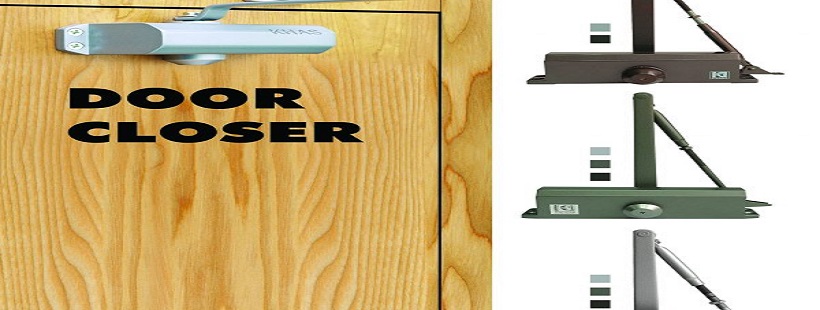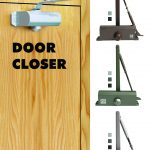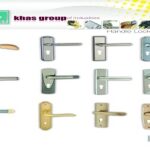Choosing the right door closers


Choosing a door closer changes depending on many different factors including customer preference, manufacturer options, and building specifications. Other factors to consider include:
- Size and weight of the door
- Location of the door
- Opening and closing frequency
- Mounting location
- Affordability
- Backswing requirements
Traffic Volume Considerations
In general, overhead door closers are used typically for medium- to heavy-traffic locations, and they are extremely durable. There are options for interior or exterior doors, and they’re one of the most common types that are used.
Floor-spring or overhead spring closers, on the other hand, are a bit more durable, and they work nicely for heavy traffic doors. Additionally, they are not visible like overhead closers, making them one of the most attractive options. Finally, concealed and frame-mounted closers are typically used for medium traffic, interior doors.
Deciding on a door closer depends on a variety of factors. It starts with understanding the various types, and the benefits that they have to offer. Then, matching the door to the type of door closer that you’re using is the key. Heavier doors and doors with higher traffic require durable, strong door closers. Lighter doors do not. Either way, if you’re unsure, the best option might be to consult with a door installer or vendor.
Building Code Considerations
Each area can have slightly different building codes depending on the location of the building. Federal, state, and even local building codes can have an impact on determining the door closer required. The Builders Hardware Manufacturers Association (BHMA) and American National Standards Institute (ANSI) provide extensive standards for door closers. The full list can be found here. Generally, each door closer needs to meet different levels of performance broken up into 3 grades with 1 being the highest and 3 being the basic level. Performance is judged based on cycle testing as well as closing force and finish tests. The tests are done in a neutral air pressure laboratory at 60-85 degrees F.
Door closers have the following requirements:
- Grade 1: 2,000,000 cycles at 60% efficiency
- Grade 2: 1,000,000 cycles at 60% efficiency
- Grade 3: 500,000 cycles at 50% efficiency
If doors are being installed into a high volume area like a major office building or shopping mall, it is crucial to only use door closers that have been rated as Grade 1 closers.
The American Disability Act also provides a list of clear requirements when looking at doors and door closers. The ADA states that interior doors should require no more than 5 lbs of force to operate and exterior doors should have the minimum force possible. The ADA also states that the closing or swing speed shall not be faster than 5 seconds and the latching speed should be quick enough to latch the door, but not slam it.
Aesthetic Considerations
A door closer might be chosen for its appearance, as some are more attractive than others. The majority of door closer units are adjustable, allowing operators to set a specific closing rate and opening resistance. Types of door closers include:
Overhead Door Closers
Overhead door closers are the most common, and they’re widely used throughout commercial properties. For example, interior doors within offices, like conference doors, are typically affixed with a door closer that automatically closes the door. Additionally, commercial front doors are also installed with a closer unit, and overhead units are a popular choice. There are three common types of overhead door closers including:
-
Regular Arm:
- The regular arm, or standard arm, the closer is a pull-side application, meaning it is located on the exterior of the door. In these applications, there are two arms, one attached to the frame and another to a spring-loaded box on the pull-side of the door. The arms, when closed, project out perpendicularly from the door, which is less attractive than other applications. This is the most power-efficient option available.
-
Top Jamb:
Top jamb door closers, like regular arm closers, have arms that project out from the door perpendicularly. Yet, the biggest difference is that the spring-loaded box is mounted on the face of the doorframe. These are often used for aluminum or glass storefront doors because these doors generally have narrow top rails. Like regular arm closers, top jamb closers are fairly power efficient.
-
Parallel Arm:
With a parallel arm application, there are two arms that sit on top of the door when it is closed. They are attached to the door via a spring-loaded box, which sits at the top of the push side of the door and powers the closing action. Parallel arm door closers are one of the most common applications, particularly in commercial properties and schools, because they reduce the risk of vandalism to the arm and they are more attractive than other overhead options. Due to the arm geometry, these are less power efficient than regular arm and top jamb closers.
Other Types of Door Closers
Although overhead closers are the most common, there are other types that aren’t mounted at the top of the door. Concealed closers, for example, are hidden within the jamb, offering a more appealing look. Similarly, floor closers are concealed within the floor and they aren’t visible when the door is opened. Examples include:
-
Concealed:
Concealed closers are fitted into recesses in the door and frame. Thus, they aren’t visible when the door is closed. They are available as hydraulic or spring-loaded versions, and they are typically used for interior doors that are fairly light.
-
Surface-mounted:
These types of door closers are fitted to the door frame, with a bar along the back of the door. Typically, these are fairly small in size, and they can be used to match the colour of the door. They are a cost-effective option for automatically closing doors.
-
Floor-Spring:
Floor-spring closers are typically used on glass storefront doors. They are mounted on the floor and are concealed. A bar within the closer is fitted into the underside of the door, which controls the closing action. These provide one of the most appealing looks, and they are often used for upscale commercial properties. Floor-spring closers typically have an open setting, so that they can be left open. Over-head spring closers are also available.
Making the Right Choice
As a building manager or owner, all this can be overwhelming. It’s essential to first consider building codes and traffic requirements before looking at the different aesthetic options. The wrong type can lead to the closer needing replacement in a short period of time and also could lead to fines. As mentioned earlier, it’s essential to choose ANSI Grade 1 closers for high volume doors. If you have a small interior office, Grade 2 door closers are acceptable and for closets, Grade 3 closers will work fine.
Once the grade requirement is met, energy efficiency and aesthetics can be taken into account. Exterior facing doors that will not be used for shipments could be left open for longer than needed leading to larger energy bills. Conversely, doors that automatically close too quickly that are used for shipments could lead to a productivity decline and later a demand that a different closer is used. The application of each door will change the type of closer needed. One way to mitigate this potential problem would be to discuss the needs of each door with someone who would be working in the area.
Recent Posts
Categories
Recent Posts
Categories
- door accessories (2)
- door fittings (2)
- Home Hardware Store (3)
- Khas Group of Industries (1)
- Khas Trading Company (2)
- Kruddson Pvt Ltd (1)





Recent Comments